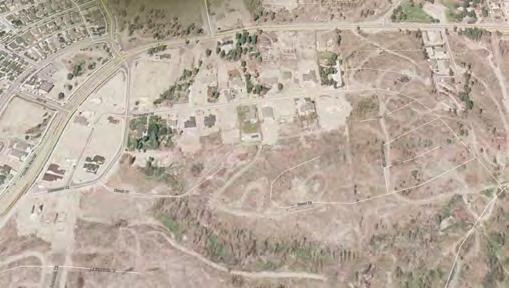4.3.2 Archetype House Vulnerability Table 30 presents the vulnerability functions for the four archetype houses under as-is conditions and conditions that follow National WUI Guide recommendations using equation 5. As noted in Section 3.7.3, equation 5 distinguishes no features besides construction that follows or does not follow recommendations in the National WUI Guide. The expected value of repair cost as a fraction of replacement cost new (called the mean damage factor) is either 50.8% (in the case of construction that does not follow the Guide) or 28.1% (construction that follows the Guide), given that the house is within 100 metres of the fire perimeter. It may seem questionable that the losses are not closer to 100% of value. However, only 54% or 38% of houses within the perimeters of the seven California wildfires of 2017–2018 ignited, according to CAL FIRE. Table 31 presents the vulnerability functions for the same houses using equations 6a–d and the odds ratios for all the observable features. These vulnerability functions are more extreme: as-is houses have mean damage factors of 70% to 85%, while houses that follow recommendations of the Guide have mean damage factors of 0.2% to 2%. Table 32 presents the vulnerability functions for the same houses using equations 9a–d and the odds ratios for only two features with the most extreme odds ratios – the highest and lowest. These vulnerability functions are more extreme than those calculated using equation 5 and less extreme than those that use all the features: as-is houses have mean damage factors between 64% and 79%, while houses that follow recommendations of the Guide have mean damage factors between 18% and 38%. It is possible that the vulnerability functions in Table 32 are more accurate than the set in Table 30 (which ignore any detailed features) and those in Table 31 (which may exaggerate the effects of following the Guide by ignoring correlation). On the other hand, they may underestimate the benefit of following the Guide. The low-exposure retrofitted house has a higher vulnerability than the moderate-to-high exposure house. Similarly, the low-exposure as-is new house has a higher vulnerability than the moderate-to-high exposure as-is new house. These are artifacts of limitations in the CAL FIRE data for pZ*, especially that the CAL FIRE odds ratio figure (Figure 4B) reflects defensible space (structure ignition zone under the National WUI Guide), but the database does not. For these reasons, the project team uses the vulnerability functions in Table 31. Table 30. Vulnerability (i.e., the response function) by equation 5 Existing Mod-high hazard
Low hazard
As-is
Follows Guide
As-is
vZ
0.94
0.74
pI
0.54
y(x=1)
0.508
70
New Mod-high hazard
Low hazard
Follows Guide
As-is
Follows Guide
As-is
Follows Guide
0.94
0.74
0.94
0.74
0.94
0.74
0.38
0.54
0.38
0.54
0.38
0.54
0.38
0.281
0.508
0.281
0.508
0.281
0.508
0.281








